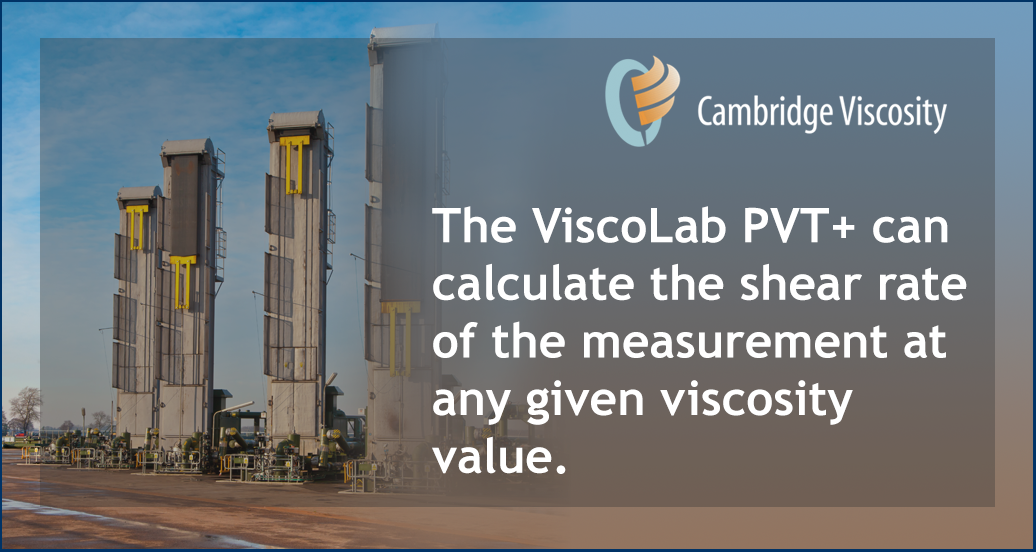 Getting rheological data that mimics subsurface conditions above 15,000 PSI and/or 200°C can be a challenge with conventional rheometers. The Cambridge Viscosity ViscoLab PVT+ offers a solution to this challenge by providing shear rates with the viscosity measurement and a shear sweep function to collect data at multiple shear rates within a single test. The PVT+ has options for measuring at pressures in excess of 30,000 PSI (or higher upon request), temperatures to 315°C, and viscosities as low as 0.02cP, which is well beyond the capability of commercially available, HPHT rheometers.
Getting rheological data that mimics subsurface conditions above 15,000 PSI and/or 200°C can be a challenge with conventional rheometers. The Cambridge Viscosity ViscoLab PVT+ offers a solution to this challenge by providing shear rates with the viscosity measurement and a shear sweep function to collect data at multiple shear rates within a single test. The PVT+ has options for measuring at pressures in excess of 30,000 PSI (or higher upon request), temperatures to 315°C, and viscosities as low as 0.02cP, which is well beyond the capability of commercially available, HPHT rheometers.
Cambridge Viscosity’s viscometers function by introducing a sample into a thermally controlled measurement chamber housing a piston. Using proven electronics, the piston oscillates within that measurement chamber with a controlled magnetic field. The movement of the piston imposes a shear stress on the liquid or gas sample, and the viscosity is determined by measuring the travel time of the piston. We use Newton’s Law of Viscosity to calculate viscosity, considering variables such as the construction parameters for the annular spacing between the measurement chamber and piston, the electromagnetic field, and travel distance of the piston. These same variables also allow us to calculate the shear rate of the measurement at any given viscosity value.
When a fluid is Newtonian, we know that the viscosity will remain the same no matter what amount of shear is applied at a constant temperature. Conversely, if the fluid is non-Newtonian, the viscosity value of the fluid will change. Depending on the material, it will increase (dilatant) or decrease (psuedoplatic). It’s important to know the properties of the fluids you’re working with, because that can impact the equipment you select, the additives you use, or the processes you adjust in your various applications.
Because it’s so important to understand how the fluid will behave under certain conditions, our PVT clients often ask us if we can help them determine whether a sample is exhibiting non-Newtonian behavior.
The answer is yes.
We’ve added a shear sweep function to the ViscoLab PVT+ , which allows users to measure viscosity at three different shear rates per piston. The PVT+ sweeps through three different shears to allow users to determine if the liquid sample is Newtonian or non-Newtonian and report out the viscosities with the corresponding shear rate at the point of measurement.
Knowing whether a fluid is Newtonian or non-Newtonian is especially important in applications like enhanced oil recovery (EOR), because you want to know whether the polymer injection fluid that is being injected downhole will maintain its viscosity or change due to different shear conditions. The viscosity of the fluid will dictate how the polymer injection flows into the subsurface environment. A non-Newtonian fluid’s viscosity will change under varying conditions and may not flow into the pores of the well as it needs to. This rheological information obtained under pressures and temperatures mimicking subsea conditions is also important for designing pumps in EOR applications to ensure that the proper rate of injection is maintained during operations.
The ViscoLab PVT+ uses our patented oscillating piston method, which allows users to manipulate the shear rate by changing the amount of force that is applied to push the piston through the sample fluid. To measure non-Newtonian fluids, we apply a different magnetic force to the piston while changing the length of the stroke (increase or decrease). This produces a different shear rate applied to the fluid. A Newtonian fluid will exhibit the same viscosity under these differing shear rates, while the non-Newtonian fluid will exhibit a different viscosity value.
The PVT+ shear sweep routine function uses three different shear rates to measure viscosity, allowing you to determine if your fluid is Newtonian or not with confidence.
Got questions? We have answers. Reach out to our Application Engineers, and we’ll get back to you ASAP.





